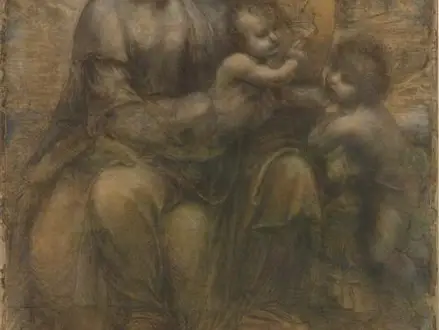Title of Artwork: “The Virgin and Child with Saint Anne and Saint John the Baptist”

Artwork by Leonardo da Vinci
Year Created 1499
Summary of The Virgin and Child with Saint Anne and Saint John the Baptist
Drawing by Leonardo da Vinci of the Virgin and Child with St. Anne and St. John the Baptist, sometimes referred to as the “Burlington House Cartoon.” Leonardo da Vinci. There are eight sheets of paper glued together for the drawing, which is done in charcoal and black-and-white chalk.”
As a result of the drawing’s large size and format, it is assumed to be a cartoon for a larger painting. To the best of my knowledge, there’s no Leonardo-inspired painting.
All About The Virgin and Child with Saint Anne and Saint John the Baptist
The Virgin Mary sits on the knees of her mother, St. Anne, holding the Child Jesus, while Jesus’ cousin, St. John the Baptist, stands to the right. To this day, the National Gallery of London houses this work of art.
Most scholars believe it was painted between 1506 and 1508 when he was travelling back and forth between Florence and Milan, but the National Gallery of Art and others believe it was painted in the late 1499s or early 1500s, towards the end of his first Milanese period.
Florentine painting of the 15th century was known for depicting the Virgin and Child with John the Baptist and the Virgin and Child with St. Anne.
In the Benois Madonna and other works by Leonardo, the positioning of the figures shifts frequently, and this drawing demonstrates this shift. A sinuous movement is created by Mary’s body turning sharply to the right, which is mirrored by Mary’s knees turning out of the painting.
On an area of the composition where one would normally find a solid foundation made up of well-placed feet, widely spread knees, and a widespread of cloak, the figures’ knees and feet establish a strong rhythmic up-and-down movement instead.
Two women’s faces are turned toward each other, mirroring one another, as the lower halves of their bodies turn away from one another. Upper body separation has become hazy, which leads one to believe that they are two separate bodies.
When the Christ Child is held almost horizontally by his mother, he rotates axially with the lower half of his body pointing upward and the upper half of his body pointing downward. It was first shown in Leonardo’s painting of the Adoration of the Magi and explored in a number of drawings, most notably the studies of the Virgin and Child with a cat that are housed in London’s British Museum.
As an important compositional element, the juxtaposition of two groups of heads is utilised. The angle, lighting, and gaze of the Christ Child resembles that of his mother, while John the Baptist’s face bears a striking resemblance to that of St. Anne. Using the lighting, viewers can tell that the scene features two protagonists and two supporting cast members. The gazes of the four people intertwine.
St. Anne’s adoring smile at her daughter Mary may indicate both her pride as a mother and the respect due to the one whom “all generations will call…blessed” Thirty years after this scene was acted out, Mary’s gaze is riveted on the Christ Child who extends a hand of blessing to his distant cousin, John the Baptist, whom he will later baptise.
Although John the Baptist is the older of the two children, he humbly accepts it as one who would later say of his cousin “I am not worthy even to unloose his sandals.”
As if to point back to the source of the blessing, St. Anne places her hand near the children’s heads, with her index finger pointing upwards towards the Heaven. When Leonardo painted The Last Supper and St. John the Baptist, he used this enigmatic gesture, which is considered to be characteristic of his work.
Information Citations
En.wikipedia.org, https://en.wikipedia.org/.























